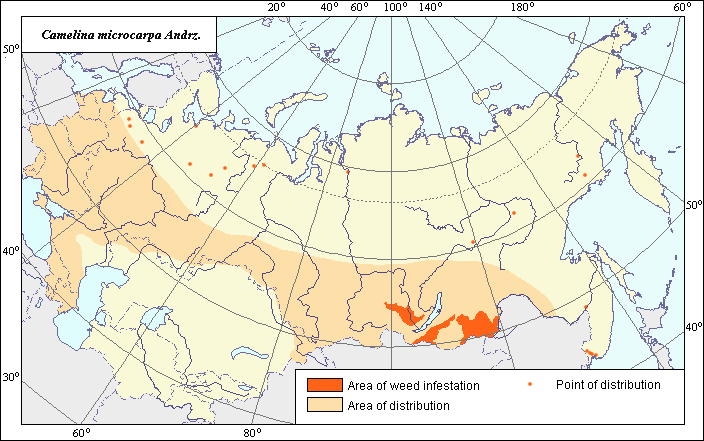Weeds
Area of distribution and harmfulness of Camelina microcarpa Andrz.
 Object description Download GIS-layers
Object description Download GIS-layers
Authors:
Object specialist - S.Yu. Larina,GIS-specialist - I.A. Budrevskaya
Data of creation:
15.03.2004Scale:
1:20 000 000Accuracy of map:
Map was created based on materials of maps of natural scale 1:5 000 000 - 1:100 000 000.Projection:
"Alber's Equal Area Conic for the USSR", 9, 1001, 7, 100, 0, 44, 68, 0, 0Basic contents:
Vector map. Area of species distribution is shown by polygons, and sporadic distribution by points. Zones of weediness are shown by polygons.Accuracy of classifier:
The weed area is subdivided into two zones, one representing species distribution, and the second where weed is considered a serious pest. Points represent locations where sporadic occurrence has been reported. The zones of harmfulness were established according to criteria of occurrence (% of fields where this species is found) and abundance (expressed as projective cover of this species in the field [in % to the field area]) where the occurrence of this species exceeded 20% with its abundance (projective cover) more than 15% (Tanskii et al., 1998).Method of map production:
Published literature was reviewed, including Atlases, monographs and papers. The areas of general distribution and harmfulness were determined according to the following sources: Volkov (1935), Hulten & Fries (1986), Nikitin (1983) and coordinated with the limits of the arable land map (Koroljeva et al., 2003). Occurrence data were obtained from herbarium specimens, floras, monographs and papers. Sites of sporadic districution were determined according to the following sources: In the Far East (Kharkevich, 1988); In the northern regions of the European part of Russia (Tolmachev, 1976); In the Caucasus (Grossgheim, 1950); In Siberia, Latvia and Lituania (Malyshev & Peshkova, 1994). In all other territories the following sources were used: Belozerov (1966), Bogachev et al. (1964), Gusev (1968), Dorogostaiskaya (1972), Krupkina & Onipko (1985), Motekaitite (1985), Shults (1976) and Yurova (2001). Data were then compiled through scanning and geo-referencing to develop a composite vector map. The biologist, together with the GIS specialist, drew a composite weed distribution area based on compiled data.Reference citations:
Belozerov P.I. 1966. New plant species for the flora of Kostroma region. Botanicheskii zhurnal, 51(6): 875-876. (In Russian)Bogachev V.K., Gorokhova V.V., Dubrovina A.V. 1964. New data on the locations of rare species in Yaroslavl region. Botanicheskii zhurnal, 49(5): 709-712. (In Russian)
Dorogostaiskaya E.V. 1972. Weed plants of the Far North of the USSR. Leningrad: Nauka. 172 pp. (In Russian)
Fomina Z.V. 1962. Weed plants of Buryatia and their control measures. Ulan-Ude: Buryatskoye knizhnoye izdatelstvo. 76 p. (In Russian)
Grossgeim, A.A. 1950. Flora of the Caucasus. Moscow-Leningrad: AN SSSR. V. 4: 311. (In Russian)
Gusev Yu.D. 1968. New and rare adventitious plants of Leningrad and Karelia flora. Botanicheskii zhurnal, 53(2): 267-269. (In Russian)
Hulten E., Fries M. 1986. Atlas of North European Vascular Plants, North of the Tropic of cancer. Konigstein. V. 1-3: 1172.
Keller B.A., ed. 1934. Weed plants of the USSR. Leningrad: AN SSSR. V. 3: 448. (In Russian)
Kharkhevich S.S., ed. 1988. Vascular plants of the Soviet Far East. Leningrad: Nauka. V. 3: 421. (In Russian)
Kolmakov P.P., Taskaeva A.G. 1985. Weed plants of Ural and their control measures. Chelyabinsk: Yuzhno-Uralskoye knizhnoye izdatelstvo. 88 p. (In Russian)
Komarov, V.L & N.A. Bush, eds. 1939. Flora of the USSR. Moscow-Leningrad: AN SSSR. V.8: 696. (In Russian)
Koroljeva IE, Vilchevskaya EV, Ruhovich DI. 2003. Digital Arable Land Map. Laboratory of Soil Information of the Dokuchaev Soil Institute, Moscow, Russia [Based on: Yanvareva LF. (ed.), Martynjuk KN., Kisileva NM. 1989. Map of Land Use, Faculty of Geography, Moscow State University, Moscow, Russia.].
Krupkina L.I., Onipko T.N. 1985. New species of higher plants for Novgorod region (particularly for Mologskii floristic region). Vestnik LGU. Biologia, 3(17): 38-44. (In Russian)
Malyshev, L.I. & G.A. Peshkova, eds. 1994. Flora of Siberia. Novosibirsk: Nauka. V. 7: 312. (In Russian)
Motekaitite V.P. 1985. About locations of new and rare ruderal species in Lithuanian SSR. Botanicheskii zhurnal, 70(4): 535-538. (In Russian)
Nikitin V.V. 1983. Weed plants of the USSR flora. Leningrad: Nauka. 454 pp. (In Russian)
Shults A.A. 1976. Adventitious flora of Riga. Botanicheskii zhurnal, 61(10): 1445-1454. (In Russian)
Tanskii V.I., Levitin M.M., Ishkova T.I., Kondratenko V.I. 1998. Phytosanitary diagnostics in integrated managemant of cereals. In: Novozhilov K.V., editor. Compendium of methodical recommendations in plant protection. Saint Petersburg: VIZR. 5-55 p. (In Russian)
Tolmachev, A.I., ed. 1976. Flora of North-East of the European part of the USSR. Leningrad: Nauka. V. 3: 294. (In Russian)
Volkov A.N., ed. 1935. Areas of distribution of the major weed plants in the USSR. Moscow-Leningrad: Izd-vo kolkhoznoi i sovkhoznoi literatury. 153 pp. (In Russian)
Yurova E.A. 2001. Floristic discoveries in Novgorod region. Botanicheskii zhurnal, 86(4): 154-155. (In Russian)
Right and copyright:
Copyright on this map and description belongs to its authors.All rights reserved. Copyright 2004© S.Yu.Larina & I.A.Budrevskaya.
The image is taken from the Internet - http://www.kb.dk/da/tema/floradanica/index.html (Flora Danica Online).

